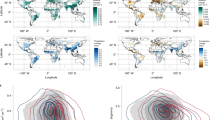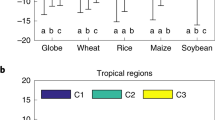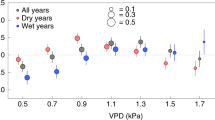Abstract
Rising air temperatures are a leading risk to global crop production. Recent research has emphasized the critical role of moisture availability in regulating crop responses to heat and the importance of temperature–moisture couplings in driving concurrent heat and drought. Here, we demonstrate that the heat sensitivity of key global crops depends on the local strength of couplings between temperature and moisture in the climate system. Over 1970–2013, maize and soy yields dropped more during hotter growing seasons in places where decreased precipitation and evapotranspiration more strongly accompanied higher temperatures, suggestive of compound heat–drought impacts on crops. On the basis of this historical pattern and a suite of climate model projections, we show that changes in temperature–moisture couplings in response to warming could enhance the heat sensitivity of these crops as temperatures rise, worsening the impact of warming by −5% (−17 to 11% across climate models) on global average. However, these changes will benefit crops where couplings weaken, including much of Asia, and projected impacts are highly uncertain in some regions. Our results demonstrate that climate change will impact crops not only through warming but also through changing drivers of compound heat–moisture stresses, which may alter the sensitivity of crop yields to heat as warming proceeds. Robust adaptation of cropping systems will need to consider this underappreciated risk to food production from climate change.
This is a preview of subscription content, access via your institution
Access options
Access Nature and 54 other Nature Portfolio journals
Get Nature+, our best-value online-access subscription
$29.99 / 30 days
cancel any time
Subscribe to this journal
Receive 12 digital issues and online access to articles
$119.00 per year
only $9.92 per issue
Buy this article
- Purchase on Springer Link
- Instant access to full article PDF
Prices may be subject to local taxes which are calculated during checkout






Similar content being viewed by others
Data availability
The datasets supporting the results of this paper are freely available from the references and links listed in Supplementary Table 1. The crop yield data are available from D.R. upon request. The intermediate datasets are available at https://github.com/clesk/couplings-heat-crops. Source data are provided with this paper.
Code availability
The processing and analysis codes are available at https://github.com/clesk/couplings-heat-crops.
References
Lobell, D. B. & Field, C. B. Global scale climate-crop yield relationships and the impacts of recent warming. Environ. Res. Lett. 2, 014002 (2007).
Lobell, D. B. et al. The critical role of extreme heat for maize production in the United States. Nat. Clim. Change 3, 497–501 (2013).
Zhao, C. et al. Temperature increase reduces global yields of major crops in four independent estimates. Proc. Natl Acad. Sci. USA 114, 9326–9331 (2017).
Schlenker, W. & Roberts, M. J. Nonlinear temperature effects indicate severe damages to U.S. crop yields under climate change. Proc. Natl Acad. Sci. USA 106, 15594–15598 (2009).
Vogel, E. et al. The effects of climate extremes on global agricultural yields. Environ. Res. Lett. 14, 054010 (2019).
Lobell, D. B., Bänziger, M., Magorokosho, C. & Vivek, B. Nonlinear heat effects on African maize as evidenced by historical yield trials. Nat. Clim. Change 1, 42–45 (2011).
Urban, D. W., Sheffield, J. & Lobell, D. B. The impacts of future climate and carbon dioxide changes on the average and variability of US maize yields under two emission scenarios. Environ. Res. Lett. 10, 045003 (2015).
Prasad, P. V. V. et al. in Response of Crops to Limited Water: Understanding and Modeling Water Stress Effects on Plant Growth Processes (eds Ahuja, L. R. et al.) 301–356 (American Society of Agronomy, Crop Science Society of America, Soil Science Society of America, 2008); https://doi.org/10.2134/advagricsystmodel1.c11
Troy, T. J., Kipgen, C. & Pal, I. The impact of climate extremes and irrigation on US crop yields. Environ. Res. Lett. 10, 054013 (2015).
Carter, E. K., Melkonian, J., Riha, S. J. & Shaw, S. B. Separating heat stress from moisture stress: analyzing yield response to high temperature in irrigated maize. Environ. Res. Lett. 11, 094012 (2016).
Matiu, M., Ankerst, D. P. & Menzel, A. Interactions between temperature and drought in global and regional crop yield variability during 1961-2014. PLoS ONE 12, e0178339 (2017).
Coffel, E. D. et al. Future hot and dry years worsen Nile Basin water scarcity despite projected precipitation increases. Earth’s Future 7, 967–977 (2019).
Rigden, A. J., Mueller, N. D., Holbrook, N. M., Pillai, N. & Huybers, P. Combined influence of soil moisture and atmospheric evaporative demand is important for accurately predicting US maize yields. Nat. Food 1, 127–133 (2020).
Schauberger, B. et al. Consistent negative response of US crops to high temperatures in observations and crop models. Nat. Commun. 8, 13931 (2017).
Ortiz-Bobea, A., Wang, H., Carrillo, C. M. & Ault, T. R. Unpacking the climatic drivers of US agricultural yields. Environ. Res. Lett. 14, 064003 (2019).
Siebert, S., Webber, H., Zhao, G. & Ewert, F. Heat stress is overestimated in climate impact studies for irrigated agriculture. Environ. Res. Lett. 12, 044012 (2017).
Lesk, C. & Anderson, W. Decadal variability modulates trends in concurrent heat and drought over global croplands. Environ. Res. Lett. 16 055024 (2021).
Berg, A. et al. Interannual coupling between summertime surface temperature and precipitation over land: processes and implications for climate change. J. Clim. 28, 1308–1328 (2015).
Seneviratne, S. I. et al. Investigating soil moisture–climate interactions in a changing climate: a review. Earth Sci. Rev. 99, 125–161 (2010).
Zscheischler, J. & Seneviratne, S. I. Dependence of drivers affects risks associated with compound events. Sci. Adv. 3, e1700263 (2017).
Trenberth, K. E. & Shea, D. J. Relationships between precipitation and surface temperature. Geophys. Res. Lett. 32, 1–4 (2005).
Seneviratne, S. I., Lüthi, D., Litschi, M. & Schär, C. Land–atmosphere coupling and climate change in Europe. Nature 443, 205–209 (2006).
Horton, R. M., Mankin, J. S., Lesk, C., Coffel, E. & Raymond, C. A review of recent advances in research on extreme heat events. Curr. Clim. Change Rep. 2, 242–259 (2016).
Berg, A. et al. Impact of soil moisture–atmosphere interactions on surface temperature distribution. J. Clim. 27, 7976–7993 (2014).
Miralles, D. G., Teuling, A. J., Van Heerwaarden, C. C. & De Arellano, J. V. G. Mega-heatwave temperatures due to combined soil desiccation and atmospheric heat accumulation. Nat. Geosci. 7, 345–349 (2014).
Ray, D. K. et al. Climate change has likely already affected global food production. PLoS ONE 14, e0217148 (2019).
Ray, D. K., Gerber, J. S., Macdonald, G. K. & West, P. C. Climate variation explains a third of global crop yield variability. Nat. Commun. 6, 5989 (2015).
Liu, B. et al. Similar estimates of temperature impacts on global wheat yield by three independent methods. Nat. Clim. Change 6, 1130–1136 (2016).
Sánchez, B., Rasmussen, A. & Porter, J. R. Temperatures and the growth and development of maize and rice: a review. Glob. Change Biol. 20, 408–417 (2014).
Welch, J. R. et al. Rice yields in tropical/subtropical Asia exhibit large but opposing sensitivities to minimum and maximum temperatures. Proc. Natl Acad. Sci. USA 107, 14562–14567 (2010).
Zhang, T., Lin, X. & Sassenrath, G. F. Current irrigation practices in the central United States reduce drought and extreme heat impacts for maize and soybean, but not for wheat. Sci. Total Environ. 508, 331–342 (2015).
Mittler, R. Abiotic stress, the field environment and stress combination. Trends Plant Sci. 11, 15–19 (2006).
Swann, A. L. S. Plants and drought in a changing climate. Curr. Clim. Change Rep. 4, 192–201 (2018).
Skinner, C. B., Poulsen, C. J. & Mankin, J. S. Amplification of heat extremes by plant CO2 physiological forcing. Nat. Commun. 9, 1–11 (2018).
Gates, D. M. Transpiration and leaf temperature. Annu. Rev. Plant Physiol. 19, 211–238 (1968).
Crafts-Brandner, S. J. & Salvucci, M. E. Sensitivity of photosynthesis in a C4 plant, maize, to heat stress. Plant Physiol. 129, 1773–1780 (2002).
Grossiord, C. et al. Plant responses to rising vapor pressure deficit. N. Phytol. 226, 1550–1566 (2020).
Rosenzweig, C. et al. Assessing agricultural risks of climate change in the 21st century in a global gridded crop model intercomparison. Proc. Natl Acad. Sci. USA 111, 3268–3273 (2014).
Eyring, V. et al. Overview of the Coupled Model Intercomparison Project Phase 6 (CMIP6) experimental design and organization. Geosci. Model Dev. 9, 1937–1958 (2016).
Seth, A. et al. Monsoon responses to climate changes—connecting past, present and future. Curr. Clim. Change Rep. 5, 63–79 (2019).
Orlowsky, B. & Seneviratne, S. I. Statistical analyses of land–atmosphere feedbacks and their possible pitfalls. J. Clim. 23, 3918–3932 (2010).
Lesk, C., Coffel, E. & Horton, R. Net benefits to US soy and maize yields from intensifying hourly rainfall. Nat. Clim. Change 10, 819–822 (2020).
Vogel, M. M. et al. Regional amplification of projected changes in extreme temperatures strongly controlled by soil moisture–temperature feedbacks. Geophys. Res. Lett. 44, 1511–1519 (2017).
Mueller, B. et al. Evaluation of global observations-based evapotranspiration datasets and IPCC AR4 simulations. Geophys. Res. Lett. 38, 1–7 (2011).
Pendergrass, A. G. et al. Flash droughts present a new challenge for subseasonal-to-seasonal prediction. Nat. Clim. Change 10, 191–199 (2020).
Mueller, N. D. et al. Global relationships between cropland intensification and summer temperature extremes over the last 50 years. J. Clim. 30, 7505–7528 (2017).
He, Y., Lee, E. & Mankin, J. S. Seasonal tropospheric cooling in northeast China associated with cropland expansion. Environ. Res. Lett. 15, 034032 (2020).
Ainsworth, E. A. & Long, S. P. 30 years of free-air carbon dioxide enrichment (FACE): what have we learned about future crop productivity and its potential for adaptation? Glob. Change Biol. 27, 27–49 (2021).
Deryng, D. et al. Regional disparities in the beneficial effects of rising CO2 concentrations on crop water productivity. Nat. Clim. Change 6, 786–790 (2016).
Challinor, A. J., Koehler, A.-K., Ramirez-Villegas, J., Whitfield, S. & Das, B. Current warming will reduce yields unless maize breeding and seed systems adapt immediately. Nat. Clim. Change 6, 954–958 (2016).
Lobell, D. B., Deines, J. M. & Di Tommaso, S. Changes in the drought sensitivity of US maize yields. Nat. Food 1, 729–735 (2020).
Bassu, S. et al. How do various maize crop models vary in their responses to climate change factors? Glob. Change Biol. 20, 2301–2320 (2014).
Harris, I., Jones, P. D., Osborn, T. J. & Lister, D. H. Updated high-resolution grids of monthly climatic observations—the CRU TS3.10 dataset. Int. J. Clim. 34, 623–642 (2014).
Rodell, M. et al. The Global Land Data Assimilation System. Bull. Am. Meteorol. Soc. 85, 381–394 (2004).
Sacks, W. J., Deryng, D. & Foley, J. A. Crop planting dates: an analysis of global patterns. Glob. Ecol. Biogeogr. 19, 607–620 (2010).
Hersbach, H. et al. The ERA5 global reanalysis. Q. J. R. Meteorol. Soc. 146, 1999–2049 (2020).
Vautard, R., Yiou, P. & Ghil, M. Singular-spectrum analysis: a toolkit for short, noisy chaotic signals. Physica D 58, 95–126 (1992).
Acknowledgements
This material is based on work supported by the National Science Foundation Graduate Research Fellowship under grant no. DGE—1644869. J.W. was supported by the National Science Foundation under grant no. BCS—184018. J.Z. acknowledges the Swiss National Science Foundation (Ambizione grant no. 179876) and the Helmholtz Initiative and Networking Fund (Young Investigator Group COMPOUNDX, grant agreement no. VH-NG-1537). S.I.S. acknowledges support from the European Union’s Horizon 2020 Research and Innovation Program (grant agreement no. 821003 (4C)) and the Swiss National Foundation in relation to the DAMOCLES COST Action (project ‘Compound events in a changing climate’). We thank J. Jägermeyr, J. Mankin, R. DeFries and M. Ting for constructive feedback on the methods and results. We acknowledge the World Climate Research Programme, which, through its Working Group on Coupled Modelling, coordinated CMIP6. We thank the climate modelling groups for producing and making available their model output, the Earth System Grid Federation (ESGF) for archiving the data, and the funding agencies who support CMIP6 and ESGF.
Author information
Authors and Affiliations
Contributions
C.L., E.C. and J.W. designed and coordinated this research. C.L. conducted the analysis. All authors discussed the methods and results and wrote the manuscript.
Corresponding author
Ethics declarations
Competing interests
The authors declare no competing interests.
Additional information
Peer review information Nature Food thanks Angeline Pendergrass and the other, anonymous, reviewer(s) for their contribution to the peer review of this work.
Publisher’s note Springer Nature remains neutral with regard to jurisdictional claims in published maps and institutional affiliations.
Supplementary information
Supplementary Information
Supplementary Figs. 1–9 and Table 1.
Source data
Source Data Fig. 1
Statistical source data.
Source Data Fig. 2
Statistical source data.
Source Data Fig. 4
Statistical source data.
Source Data Fig. 5
Statistical source data.
Source Data Fig. 6
Statistical source data.
Rights and permissions
About this article
Cite this article
Lesk, C., Coffel, E., Winter, J. et al. Stronger temperature–moisture couplings exacerbate the impact of climate warming on global crop yields. Nat Food 2, 683–691 (2021). https://doi.org/10.1038/s43016-021-00341-6
Received:
Accepted:
Published:
Issue Date:
DOI: https://doi.org/10.1038/s43016-021-00341-6
This article is cited by
-
Global spatially explicit yield gap time trends reveal regions at risk of future crop yield stagnation
Nature Food (2024)
-
Contrasting sensitivity of air temperature trends to surface soil temperature trends between climate models and reanalyses
npj Climate and Atmospheric Science (2024)
-
A dual-selective thermal emitter with enhanced subambient radiative cooling performance
Nature Communications (2024)
-
Risks of synchronized low yields are underestimated in climate and crop model projections
Nature Communications (2023)
-
Global risk assessment of compound hot-dry events in the context of future climate change and socioeconomic factors
npj Climate and Atmospheric Science (2023)



